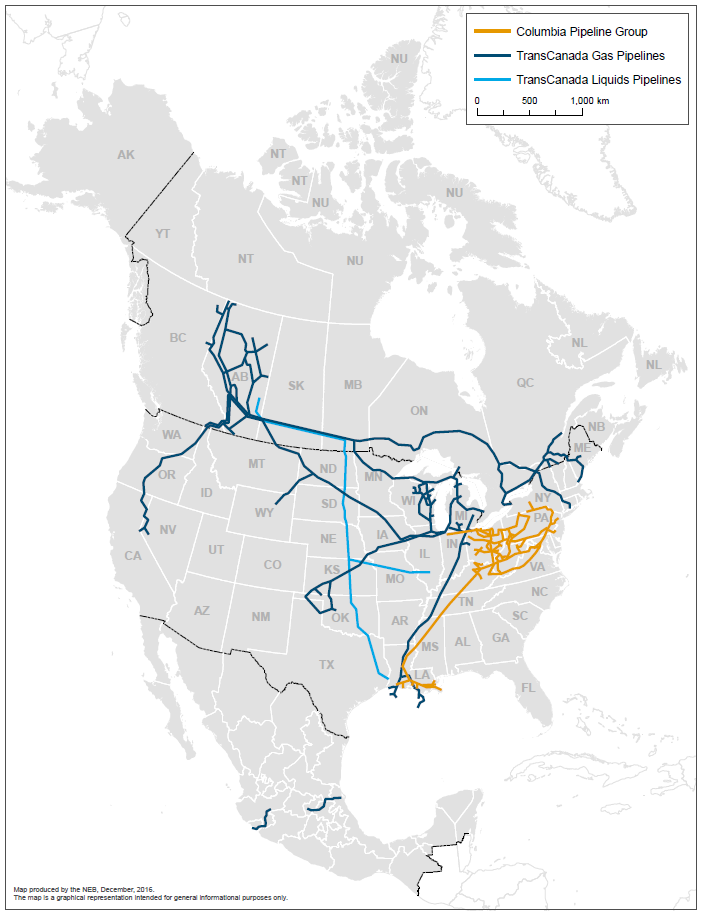2016 Review: Major pipeline deals dominate energy mergers and acquisitions
Release date: 2017-01-13
Canada’s two largest pipeline companies – TransCanada and Enbridge – both made significant deals in 2016. According to Bloomberg, the two deals accounted for more than 70% of Canadian mergers and acquisitions announced through mid-December. On 17 March 2016, TransCanada Corp. (TransCanada) announced that it would acquire Houston-based Columbia Pipeline Group Inc. (Columbia) for US$13 billion. The transaction was completed on 1 July 2016 and created a 91 000 km natural gas pipeline system that reaches across North America. TransCanada plans to divest US$7 billion in predominantly non-gas power assets to fund the acquisition.
Over the past decade, TransCanada has faced challenges maintaining natural gas throughputs on its Canadian Mainline from western Canada to eastern markets. In large part, this is due to increasing gas production from the Northeast U.S. Marcellus shale formation displacing western Canadian production. Columbia has a significant presence in the Marcellus and now provides TransCanada with access to production from this region and the ability to connect it to eastern and Gulf Coast markets.
Map of TransCanada’s and Columbia’s Pipeline Assets
Source and Description
Source: NEB
Description: This map of Canada, the U.S., and Mexico illustrates TransCanada’s natural gas and liquids pipelines, as well as Columbia’s pipelines. TransCanada’s gas pipelines are located across Canada and the U.S. and include two operating pipelines in Mexico. TransCanada’s crude oil pipelines link Alberta with the U.S. Midwest and Gulf Coast. Columbia’s pipelines are located in the U.S. and link Marcellus production in the northeast U.S. with eastern and Gulf Coast markets. This map is a graphical representation intended for general informational purposes only.
Source: NEB
On 6 September 2016, Enbridge Inc. (Enbridge) announced it would purchase Houston-based Spectra Energy Corp. (Spectra) for US$28 billion. The deal is slated to close in early 2017, subject to shareholder and regulatory approvals. If finalized, this transaction would create North America’s largest energy infrastructure company, with more than 195 000 km of oil and natural gas pipeline networks.Footnote 1.
Currently, Enbridge’s pipelines predominantly send oil from Alberta’s oil sands to U.S. Midwest and Ontario refineries, while Spectra’s pipelines mainly transport gas from North American production regions to the eastern half of the U.S. The merger provides Enbridge with almost equal diversification between oil and gas.
Map of Enbridge’s and Spectra’s Pipeline Assets and Gas Distribution Areas
Source and Description
Source: NEB
Description: This map of Canada, the U.S., and Mexico illustrates TransCanada’s natural gas and liquids pipelines, as well as Columbia’s pipelines. TransCanada’s gas pipelines are located across Canada and the U.S. and include two operating pipelines in Mexico. TransCanada’s crude oil pipelines link Alberta with the U.S. Midwest and Gulf Coast. Columbia’s pipelines are located in the U.S. and link Marcellus production in the northeast U.S. with eastern and Gulf Coast markets. This map is a graphical representation intended for general informational purposes only.
The NEB regulates interprovincial and international Canadian pipelines owned by TransCanada, Enbridge, and Spectra. The NEB does not regulate pipelines located in the United States, nor does it conduct competition-related reviews of mergers and acquisitions.
- Date modified:


